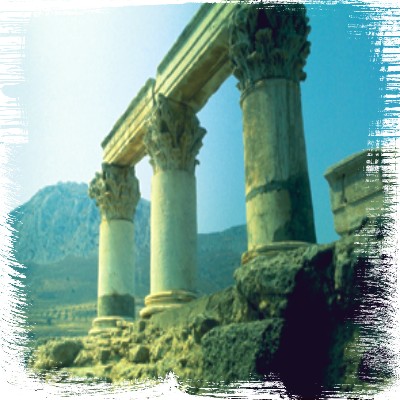

As
the mists of history begin to dissolve, the first recorded king of Corinth
was Aletes, leader of the Dorians, who occupied the area around 1000-900
BC. In the eighth century BC, the Bacchiad tyrants of Corinth founded
colonies in Corcyra (Corfu) and Syracuse, making their home city the
greatest Greek naval power. Fresh impetus to the development of the city
was given by the Cypselid dynasty (Cypselus, Penander). Shipping, trade
and the fine arts flourished, and many important buildings were erected.
In 580 BC, Sparta overthrew the tyranny of Corinth and established an
aristocratic system of government. Corinth now became associated with
Sparta and its Peloponnesian allies, and challenged Athens for supremacy
in Greece. However, during the sixth and fifth
centuries BC, Athens increased its power and overshadowed Corinth.  Not
long time after the Peloponnesian war where Athens was defeated, Corinth
turned on its former ally and, with other Greek cities, attacked Sparta in
what is known as the Corinthian War (395-387 BC). In 338 BC the city was
captured by Philip ÉÉ of Macedonia, and in 243 BC it joined the Achaean
Confederacy. Leucius Mommius sacked Corinth in 146 BC, but Julius Caesar
rebuilt it in 44 BC. During the first century AD, Corinth was the capital
of the Roman province of Achaea, and in the second century AD, its superb
build helped to give back to Corinth a lot of the grandeur it had enjoyed
in former times. In Byzantine times and later on, Corinth attracted the
attention of wave after wave of invaders: Heruli, Goths, Normans,
Crusaders, Franks, Venetians and last of á11, Turks. Liberation from the
Turks came in 1822, but in 1858 á devastating earthquake laid Corinth
waste and the surviving townspeople built the modem town ('New Corinth').
Not
long time after the Peloponnesian war where Athens was defeated, Corinth
turned on its former ally and, with other Greek cities, attacked Sparta in
what is known as the Corinthian War (395-387 BC). In 338 BC the city was
captured by Philip ÉÉ of Macedonia, and in 243 BC it joined the Achaean
Confederacy. Leucius Mommius sacked Corinth in 146 BC, but Julius Caesar
rebuilt it in 44 BC. During the first century AD, Corinth was the capital
of the Roman province of Achaea, and in the second century AD, its superb
build helped to give back to Corinth a lot of the grandeur it had enjoyed
in former times. In Byzantine times and later on, Corinth attracted the
attention of wave after wave of invaders: Heruli, Goths, Normans,
Crusaders, Franks, Venetians and last of á11, Turks. Liberation from the
Turks came in 1822, but in 1858 á devastating earthquake laid Corinth
waste and the surviving townspeople built the modem town ('New Corinth').
The archaeological site is not far from the town. Among the features are the ruins of the Roman forum, with magnificent buildings, temple Å (the temple of Octavia), á row of small Roman temples, the superb Doric temple of Áñïllï (540 BC), the temple of Hera Acraea and the Glauce Fountain, numerous shops and arcades basilicas dating from Roman times, administrative buildings, the elaborate Peirene fountain, the Odeion and the Asklepeion. In the site, there is a museum with fascinating exhibits, which in whole reflect the long and glorious history of Corinth.